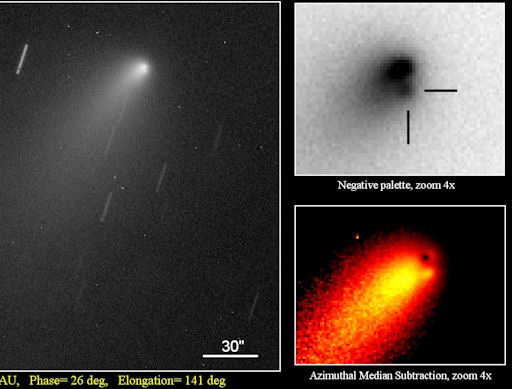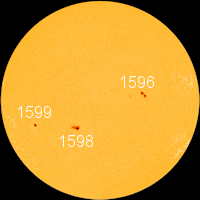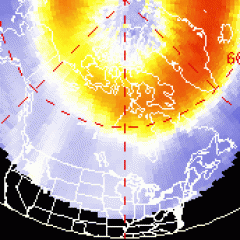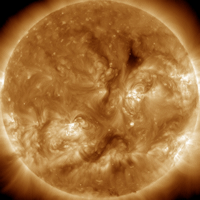SUBSIDING CHANCE OF FLARES: Sunspot AR1598 has decayed since it unleashed an X1-class solar flare on Oct. 23rd. The daily odds of a similar eruption from the active region have dropped to only 5%, according to NOAA forecasters. Solar flare alerts: text, voice.
A COMET IN TROUBLE? Amateur astronomers have been keeping a close eye on Comet 168P/Hergenrother since October 1st when it suddenly brightened 500-fold, from 15th to 8th magnitude. At the time, the comet was making its closest approach to the sun (1.4 AU). Some observers speculated that solar heating caused the fragile comet to break apart. On Oct. 26th, a group of astronomers found evidence to support this idea. "Using the Faulkes North (F65) telescope," writes Ernesto Guido et al., "we detected a fragmentation in Comet 168P."
"Our images, taken on Oct. 26th, reveal the presence of a secondary nucleus, or fragment, about two arcseconds away from the main central condensation of comet 168P." This is probably a chunk of rocky ice emerging from the haze of gas and dust that surrounds the main nucleus, still hidden inside. Comets are notoriously fragile, so its no surprise that Comet 168P/Hergenrother is breaking apart in this way.
The only question is, what happens next? Will the comet spit in two, with two heads and two tails, one tracking the fragment and the other tracking the parent? Or is this the prelude to a more complete disintegration? Amateur astronomers are encouraged to monitor developments while the comet remains bright enough to see through backyard telescopes. Here are the comet's coordinates. For best results, we recommend the Comet Hunter Telescope.

![]()
Solar wind
speed: 313.0 km/sec
density: 0.5 protons/cm3
explanation | more data
Updated: Today at 1607 UT
![]()
X-ray Solar Flares
6-hr max: B9 1235 UT Oct27
24-hr: C1 0411 UT Oct27
explanation | more data
Updated: Today at: 1600 UT
![]()
![]()
![]()
Daily Sun: 26 Oct 12
![]()
![]()
Decaying sunspot 1598 poses a slim threat for M-class solar flares. Credit: SDO/HMI
![]()
![]()
![]()
Sunspot number: 71
What is the sunspot number?
Updated 26 Oct 2012
Spotless Days
Current Stretch: 0 days
2012 total: 0 days (0%)
2011 total: 2 days (<1%)
2010 total: 51 days (14%)
2009 total: 260 days (71%)
Since 2004: 821 days
Typical Solar Min: 486 days
Update 26 Oct 2012
The Radio Sun
10.7 cm flux: 130 sfu
explanation | more data
Updated 26 Oct 2012
![]()
![]()
![]()
Current Auroral Oval:
![]()
Switch to: Europe, USA, New Zealand, Antarctica
Credit: NOAA/POES
![]()
![]()
![]()
Planetary K-index
Now: Kp= 1 quiet
24-hr max: Kp= 1 quiet
explanation | more data
![]()
Interplanetary Mag. Field
Btotal: 5.1 nT
Bz: 0.5 nT south
explanation | more data
Updated: Today at 1606 UT
![]()
![]()
![]()
Coronal Holes: 26 Oct 12
![]()
![]()
There are no large coronal holes on the Earthside of the sun. Credit: SDO/AIA.





